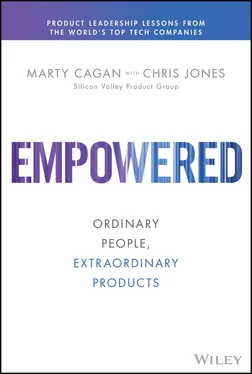This is a relationship that depends on trust. The product person must understand and believe that you as the manager are genuinely and sincerely committed to helping her reach her full potential. That is your primary job as the manager. If the product person is effective and gets promoted, you did your job. Likewise, if the product person is not able to reach competence, you have failed. And the product person needs to understand that for you both to succeed, you'll need to be able to trust and depend on each other, and most important, to be able to speak honestly and frankly.
With most new product people, there is a necessary and critical onboarding period where the person acquires the skills and knowledge required to get up to speed (reach competence).
Every person is different, bringing different experience and knowledge to the job. In Chapter 8, The Assessment, I discussed a tool I use to quickly assess a new product person to determine which areas to focus on. But, until the product person is strong enough to be considered competent, it is your responsibility to ensure the person is not doing harm to her team and is making reasonable decisions.
Normally, this period of close oversight lasts on the order of two to three months, and it is a much more intense coaching relationship than the ongoing coaching that happens once the product person is deemed capable.
This is one of those areas where there's a range of opinions out there, but I feel strongly that the 1:1 should be no less than 30 minutes, once per week, and that this session is sacred and not to be another one of those “You okay with skipping this week?” kind of meetings. You may need to occasionally reschedule, but don't cancel. Please consider the message this sends.
For new PMs in the onboarding period who are not yet competent, it may be two to three times per week, or even daily.
Once the trust between manager and employee is established, 1:1 coaching works well with video calls. The key is to establish an environment conducive to developing the relationship and having honest, constructive discussions.
If you are to empower your product person to solve problems in the best way her team sees fit, as a leader and manager you must provide her with the strategic context.
This means making sure she understands the company's mission and objectives for the year, the product vision, the product strategy for the broader product, and the team objectives for her particular product team.
The bulk of this discussion happens during onboarding, but each quarter you'll need to discuss the upcoming quarter's specific team objectives. Sometimes, those are fairly complicated discussions.
There's simply no substitute for the product person doing her homework. It is the foundation for competence, and it's the main activity during the onboarding period. You can guide the product person to the right resources, and answer questions about the material, but it's on the person to spend the time and effort to do her homework and gain this knowledge.
What does homework really mean? For a product manager, it means learning the product inside and out. Learning about the users and customers. Learning the data. Learning the capabilities of the enabling technologies. Learning the industry. Learning the various dimensions of the business, especially financial, sales, go‐to‐market, service, and legal.
Thinking and Acting Like a Product Person
Beyond doing homework, coaching is mainly about helping the product person learn to think and act like a strong product person.
What does it mean to think like a product person? It means focusing on outcome. Considering all of the risks—value, usability, feasibility, and business viability. Thinking holistically about all dimensions of the business and the product. Anticipating ethical considerations or impacts. Creative problem solving. Persistence in the face of obstacles. Leveraging engineering and the art of the possible. Leveraging design and the power of user experience. Leveraging data to learn and to make a compelling argument.
What does it mean to act like a product person? Listening. Collaborating. Shared learning. Evangelizing. Inspiring. Giving credit and accepting blame. Taking responsibility. Knowing what you can't know and admitting what you don't know. Demonstrating humility. Building relationships across the company. Getting to know customers on a personal level. Leading.
Also known as “connecting the dots.” You can't expect every product person to be able to stay on top of what all the other product teams are doing. One of the important benefits of the 1:1 is that you are aware of what activities and issues are occurring in the various teams, and you may very likely be the first one to see an issue brewing or duplication occurring. It is your job to point out these potential areas of conflict or impact and encourage the product person to collaborate with the relevant colleagues to resolve, and if necessary, for you to make a decision to remove the conflict.
Also known as “tough love” or “radical candor,” honest, constructive feedback is the main source of value you provide as manager. Feedback should be frequent and as timely as possible (at the first opportunity to discuss privately). Remember to praise publicly but criticize privately.
Many managers mistakenly believe that the only time they should collect and deliver feedback is at an annual performance review, but in truth there are opportunities every day to collect feedback, both directly and indirectly. There is usually no shortage of meetings with the opportunity to observe the product person's interactions directly.
Moreover, as the manager, you should always be seeking constructive feedback on the person—asking the other members of the product team about their interactions and asking senior executives, stakeholders, and business owners about their impressions and suggestions.
After a while, giving constructive feedback moves from awkward to second nature. But until then, force yourself to come up with some helpful constructive feedback every week .
Hopefully, it's clear to you that product jobs are very hard. It is a journey not a destination. You can have 25 years of hands‐on product experience and you will still be learning and improving. Every product effort has its own risk profile. New enabling technologies constantly emerge. Today's services are tomorrow's platforms. Markets develop. Customer behaviors change. Companies grow. Expectations rise.
The best product leaders measure their success in how many people they've helped earn promotions, or have moved on to serve on increasingly impactful products, or to become leaders of the company, or even to start their own companies.
I could end the chapter here, but I have seen so many managers who think they understand and do all this, yet fail to develop their people. In my experience, here are the most common reasons for that:
Manager Just Doesn't Care
By far the biggest reason I see that people don't develop and reach competence is because so many managers either don't like developing people, or they don't view it as their primary responsibility. So, it's pushed off as a secondary task, if that, and the message to the employee is clear: You're on your own.
Manager Reverts to Micromanaging
Читать дальше











